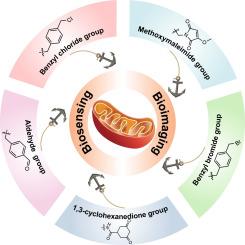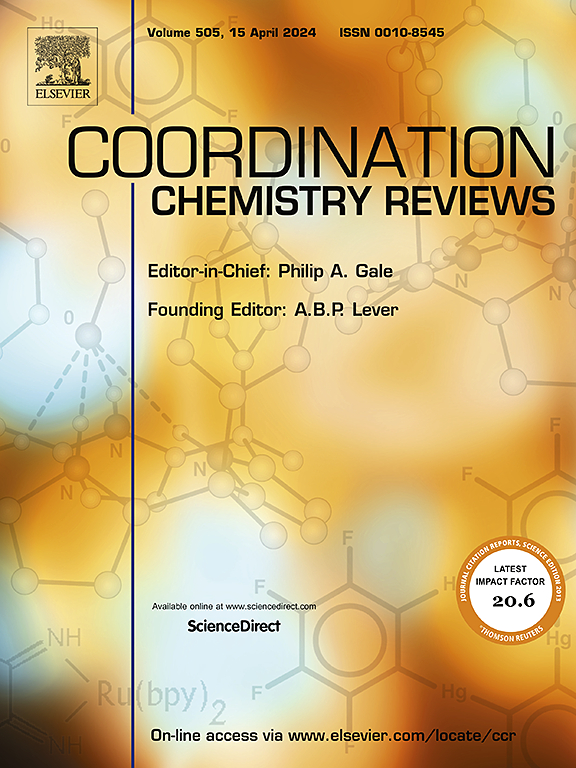用于高保真生物成像的线粒体固定化荧光探针:从设计到应用
IF 20.3
1区 化学
Q1 CHEMISTRY, INORGANIC & NUCLEAR
引用次数: 0
摘要
线粒体作为一种重要的细胞器,在各种细胞活动和代谢过程中发挥着独特而重要的作用。然而,线粒体功能障碍的发现与许多人类疾病密切相关。目前,大量线粒体靶向荧光传感器和治疗剂已被用于监测各种生物标志物和疾病治疗。然而,这些基于静电相互作用的载体不可避免地具有远离线粒体基质的扩散倾向,导致检测结果不准确,定位信息不稳定。因此,为了获得具有高保真成像质量的精确结果,线粒体固定探针由于其线粒体固定能力和可激活的传感能力而不受线粒体自噬和去极化过程的影响而越来越受到关注。在这篇综述中,我们概述了线粒体固定化探针的设计策略,这些探针已被用于微环境、生物反应物质和酶的检测以及其他光疗应用。此外,我们还强调了线粒体锚定探针在未来的挑战和机遇。我们期望这一综述将促进新的线粒体固定荧光探针的发展,以更好地揭示线粒体和其他细胞器中重要的病理变化和过程。本文章由计算机程序翻译,如有差异,请以英文原文为准。


Recent mitochondria-immobilized fluorescent probes for high-fidelity bioimaging: From design to application
As a significant organelle, mitochondria play unique and especially essential roles in a variety of cellular activities and metabolism processes. However, the discovery of mitochondria dysfunction is tightly related to many human diseases. Currently, quantities of mitochondria-targetable fluorescent sensors and theranostic agents have been exploited to monitor various biomarkers and disease treatment. Nevertheless, these electrostatic interaction-based vehicles inevitably have a tendency to diffuse away from mitochondrial matrix leading to the inaccurate detection results and unstable localization information. Thus, to enable a precise result with a high-fidelity imaging quality, mitochondria-immobilizable probes are attracting increasing attention due to their mitochondria fixable ability and activatable sensing capability without the influence during mitophagy and depolarization process. In this review, we summarily provided an insight overview into the design strategy of mitochondria-immobilizable probes that have been employed into microenvironment, bioreactive species and enzymes detection and other phototherapy applications. Additionally, we also highlighted the challenges and opportunities of mitochondria-anchored probes in the future. We expected that this review will prompt the development of novel mitochondria-fixable fluorescent probes for better unraveling the important pathological variation and processes in mitochondria as well as other organelles.
求助全文
通过发布文献求助,成功后即可免费获取论文全文。
去求助
来源期刊

Coordination Chemistry Reviews
化学-无机化学与核化学
CiteScore
34.30
自引率
5.30%
发文量
457
审稿时长
54 days
期刊介绍:
Coordination Chemistry Reviews offers rapid publication of review articles on current and significant topics in coordination chemistry, encompassing organometallic, supramolecular, theoretical, and bioinorganic chemistry. It also covers catalysis, materials chemistry, and metal-organic frameworks from a coordination chemistry perspective. Reviews summarize recent developments or discuss specific techniques, welcoming contributions from both established and emerging researchers.
The journal releases special issues on timely subjects, including those featuring contributions from specific regions or conferences. Occasional full-length book articles are also featured. Additionally, special volumes cover annual reviews of main group chemistry, transition metal group chemistry, and organometallic chemistry. These comprehensive reviews are vital resources for those engaged in coordination chemistry, further establishing Coordination Chemistry Reviews as a hub for insightful surveys in inorganic and physical inorganic chemistry.
 求助内容:
求助内容: 应助结果提醒方式:
应助结果提醒方式:


